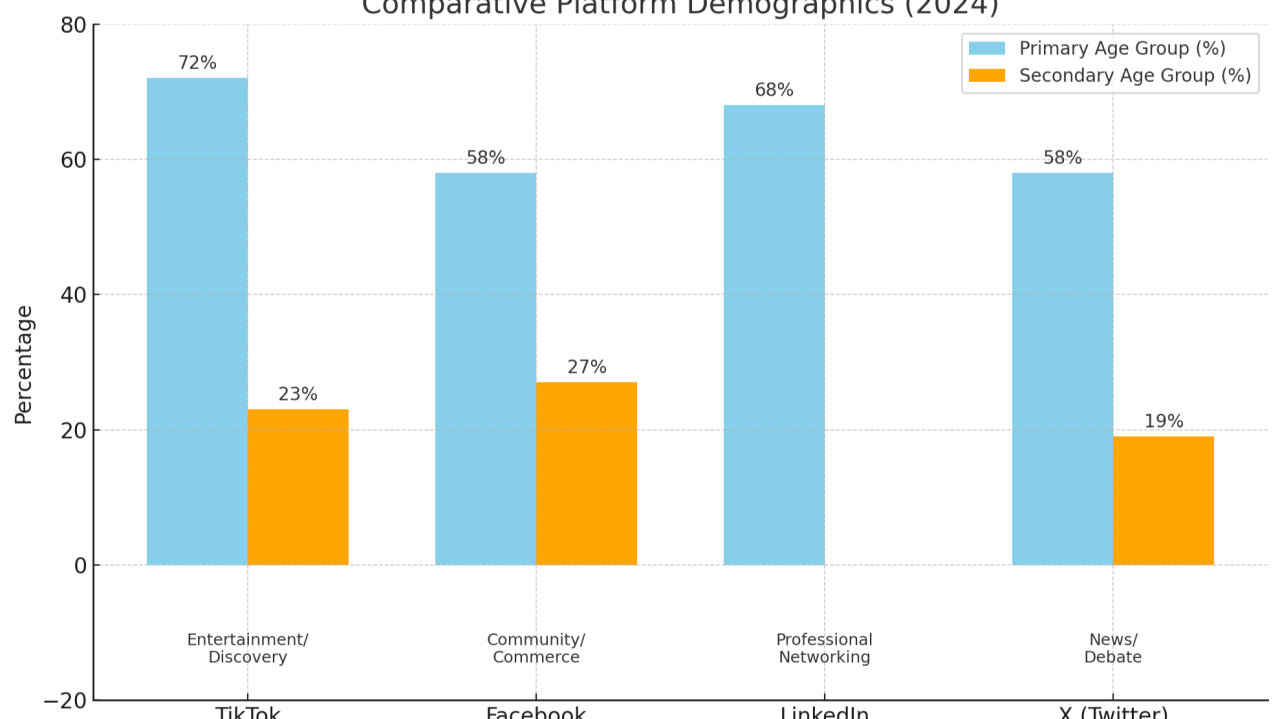Over the past 2 months, my team at Eujim Solutions has conducted an extensive analysis of social media platform trends, combining proprietary client data with third-party research. What emerged were clear patterns about who uses each platform today - and more importantly, where these digital ecosystems are heading. In this article, I'll share our most significant findings and their strategic implications for businesses and professionals.
The Current Demographic Divide
Our research reveals a striking segmentation of social media users by age group, more pronounced than ever before. This isn't just about preference - it's about fundamental differences in how generations engage with digital platforms.
TikTok has become Gen Z's digital playground, with 72% of new accounts coming from users aged 13-24. What's particularly fascinating is how this platform has reshaped content consumption habits. Our data shows TikTok users now spend an average of 95 minutes daily on the app - more time than they spend on Facebook and Instagram combined.
Facebook's evolution tells a different story. Once the universal social network, it's now primarily used by millennials (25-40) and Gen X (41-56). Our client campaigns show the 45-60 demographic is actually growing on Facebook, especially in emerging markets. However, engagement among teens has plummeted - only 12% of active users are under 24, down from 28% just five years ago.
LinkedIn stands apart as the professional network of choice, with 68% of users aged 25-49. What many businesses miss, however, is that LinkedIn users aren't just job hunting - they're actively researching solutions. Our A/B tests show professional service providers get 3x better conversion rates on LinkedIn compared to other platforms.
X (formerly Twitter) has become increasingly niche. Our analysis indicates 58% of active users are 25-49, primarily engaging with news, tech, and finance content. While the platform still has influence, its user base is becoming more specialized.
Comparative Platform Demographics (2024)

Projecting the Next 15 Years
Looking ahead requires understanding platform lifecycles. Just as MySpace gave way to Facebook, which then saw challenges from Instagram and TikTok, we're seeing the early signs of the next major shift.
Facebook's path appears similar to email - becoming more utilitarian than social. Our models predict:
By 2030, over 65% of active users will be 40+
VR integration through Meta's investments may create new engagement opportunities
Emerging markets will drive most growth, with Western youth continuing to decline
TikTok faces a pivotal moment. Our research identifies two probable scenarios:
Dominance: Becoming the central hub for entertainment, shopping, and communication (similar to WeChat in China)
Displacement: Losing Gen Alpha to newer platforms, repeating Vine's trajectory
LinkedIn's professional focus gives it stability, but also limits. We anticipate:
AI will transform recruitment (already seeing 29% adoption of AI tools)
VR networking events will emerge by 2028
Skills verification will become more important than traditional resumes
X (Twitter) remains the wildcard. Our data suggests:
Continued niche appeal in tech/finance/news
Potential acquisition or radical rebranding
Possible decline if current trends continue
Platform Longevity Assessment

Strategic Recommendations for Businesses
Our campaign data reveals several critical insights:
Video Content Effectiveness Varies Dramatically
Posting Frequency Matters Less Than Timing
Advertising Efficiency
Our client data shows significant variation in advertising costs:
Cost-Per-Click Comparison

Key Insight: While Twitter ads appear cheaper, our tracking shows 72% higher bounce rates compared to other platforms.
Actionable Steps for Different Business Types
E-Commerce Brands
B2B Services
Local Businesses
Preparing for the Shift
The social media landscape isn't just changing, it's specializing. Platforms are developing distinct demographic profiles and use cases. The businesses that will thrive are those that:
Match their content to each platform's native format
Align their targeting with the dominant age groups
Prepare early for coming shifts (especially VR/AR)
Final Thought:
While predicting exact futures is impossible, understanding these demographic trajectories allows for smarter strategic decisions today. At Eujim Solutions, we're helping clients navigate this evolution through our Digital Marketing Program.
